Plasma biological combined deodorization process for steel drum coating exhaust gas
Jiefuyi Metal Container (Shanghai) Co., Ltd.
1. Summary
China has achieved rapid economic development. China, the United States, and Japan are also facing the problem of improving the management of environmental pollution and pollution emissions while economic development.
Jiefuyi Metal Container (Shanghai) Co., Ltd. was founded in April 1998. Since the location of the company belongs to the “general industrial zone†where residents live and live, in order not to affect the living environment of the surrounding residents of the company, the company invested relevant equipment in the initial stage of plant construction to meet the environmental assessment requirements of the state. . Since the odor problem encountered in the coating process of steel drums needs further improvement, the company began to develop the plasma bio-deodorization process for the exhaust gas of steel drum coating Production Line in September 2007. After the use of the equipment for deodorization of painted exhaust gas in March 2008, our company has not received a complaint from neighboring residents and enterprises due to the stench of emissions.
In the domestic steel drum industry, our company is the first to develop and utilize the plasma bio-deodorization process technology with good deodorization effect.
2. Odor pollutant emission limits
Emission of odor pollutants from steel drum production lines shall be carried out in accordance with the emission limit standards stipulated in the national “odorous pollutant discharge GB14554-93â€.
Table 1
Odor concentration
Remarks
Emission limit standard
≤2000
The odor emission requirement after treatment reaches the odor emission concentration
≤2000 (exhaust chimney height 15M~20M)
Plasma bio combination deodorization process before use
>2000
Exceeding emission limit standards, need to be improved
experiment method
Sampling before odor treatment and after odor treatment
Refer to GB/T14675 test method
Odor emission concentration
Odor emission concentration; means that the odor (including odor) is diluted with odorless air, and when diluted to just odorless, the required dilution factor is expressed.
3. The main source of odor
The steel drum coating line is the main source of odor generation. Table-2. shows the status of solvent-based coatings used in our coating line.
Table 2.
Number of painted parts
Paint type
Coating, solvent usage
Steel drum outside painting
888,000 barrels per year
Alkyd resin
129t/year, 84t/year
Steel drum inner surface coating
312,000 barrels per year
Epoxy phenolic system, polyvinyl fluoride resin
56t/year, 11t/year
4. Reasons for selection of microbial deodorization method
Known exhaust gas treatment deodorization includes "microorganism", "direct combustion", "catalytic combustion", "activated carbon", "condensation and washing" and the like. Table-3 shows a comparison of various deodorization methods.
table 3.
project
microorganism
Direct combustion
Catalytic combustion
Activated carbon
Condensation wash
1
Deodorization ability
â—‹
â—‹
â—‹
â–³
â–³
2
Operational
â—‹
â—‹
â–³
â—‹
â—‹
3
Initial investment
â—‹
â–³
â–³
â—‹
â—‹
4
Operating costs
â—‹
â–³
â–³
â–³
â–³
1) The combustion method is likely to cause adverse effects of secondary exhaust emissions.
2) The activated carbon and condensate washing methods have limited ability to deodorize the painted exhaust gas.
Table-4. Comparison of investment cost and operating cost of deodorization equipment (1 case)
Table 4.
Biological deodorization
Catalytic combustion deodorization
Equipment investment fee (thousands)
760
950~2040
Operating cost (yuan/barrel)
0.098
0.802~1.100
1) Catalytic combustion Deodorization is a technically mature deodorization method that is now widely used.
2) Microbial deodorization is a new deodorization method developed in recent years, which has a comparative advantage in equipment investment and operating cost, and is easy to operate.
According to the survey results of Table-3. and Table-4., our company finally chose the “microbial†deodorization method.
5. Deodorization mechanism of microbial deodorization tower
figure 1.
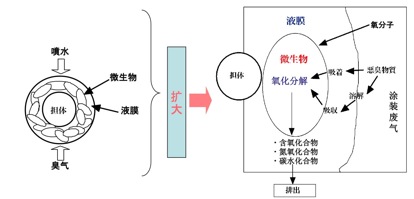
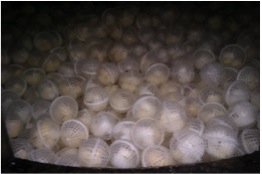
â– When the malodorous substance in the coating exhaust gas passes, it is dissolved and absorbed by the water on the support. It is then oxidatively decomposed by microorganisms living on the surface of the support and discharged.
â– In order to maintain the water replenishment required for microbial survival, the sprinkler compartment in the microbial deodorization tower sprays the support layer. The water source is circulating water containing bacteria in the water tank below the microbial deodorization tower.

â– Features of the use of microbial deodorization systems
1 Easy to manage and easy to operate.
2 Maintain low management fees. Just pay for the power such as a fan.
4 The microbial deodorization tower filling volume; the deodorizing air volume is about 15000 m3/Hr.
5 The microbial support is replaced once every two years.
â– Bacteria (yeast?yeasts)
1 Living temperature conditions; above freezing point, the winter circulating water tank needs to be heated.
2 microbial bait; coating C, N, P and other elements in the exhaust gas. Powdered glucose is added regularly to supplement the C element content required for microbial survival.
3 Regularly observe the survival of microbial bacteria with a microscope. If microbial death occurs, the dry bacteria can be revived into the microbial tower sink.
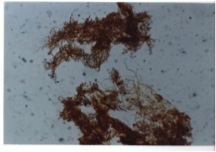
Biological bacteria SEM photo

Biological bacteria SEM photo (expanded)
6. The role of the plasma generator
1) At the beginning we used a cooling tower and a microbial deodorization tower for testing. It was found in the test that the cause of death of microorganisms is related to the presence of tar components in the exhaust gas. In order to prevent the occurrence of microbial death, a plasma generating device is installed.
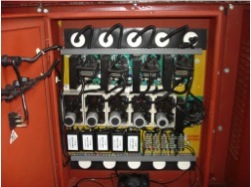
2) Under the multiple actions of high-energy electrons and strong radical oxidation, the molecular chain of organic molecules in the gas is broken, and a series of redox reactions occur, so that the tar component in the coated exhaust gas can be decomposed and removed.
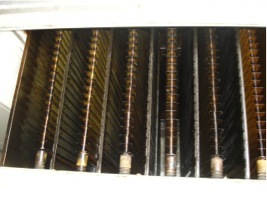
3) Ozone is generated by the use of a plasma generating device, which has a certain impact on the survival of microorganisms. After the chemical vapor cleaning device is disposed at the rear end of the plasma generating device, residual ozone is eliminated.
7. Painted exhaust gas deodorization equipment
figure 2.
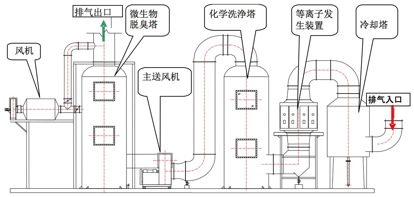
1) The amount of exhaust gas deodorization treatment; the amount of hurricane into the air? 15000m3/Hr
2) target value of odor treatment; dilution factor ≤ 2000
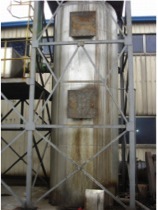
Microbial deodorization tower

Chemical washing tower
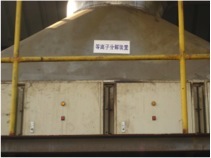
Plasma generating tower

Cooling Tower
â– Exhaust gas treatment of each device
1) Cooling tower; continue to cool the high-temperature exhaust gas by spraying and dispersing water (90 ° C → 40 ° C)
2) The plasma generating tower; under the multiple actions of high-energy electrons and strong radical oxidation, the organic molecular chain in the exhaust gas is broken, and a series of redox reactions occur, so that the tar component in the coating exhaust gas is decomposed and removed.
3) Chemical cleaning tower; spraying with NaOH aqueous solution (pH? 9-11) to remove residual chemical decomposition products and ozone.
4) Microbial deodorization tower; the microorganisms survive in a sponge carrier filled with a porous zygote of a diameter of 100 mm. The biodegradation process is used to degrade the degradable components in the exhaust gas into oxygenates, nitrogen oxides, and carbohydrates. The porous activated carbon is then used to absorb undegraded components of the exhaust gas.
8. Painted exhaust gas deodorization equipment effect
After the application of the exhaust gas deodorization equipment in March 2008, we tested the odor concentration entering the inlet of the exhaust gas deodorization equipment and the odor concentration after treatment by the deodorization equipment. According to the test results, it was confirmed that the odor concentration after the treatment by the deodorizing apparatus was lowered to 60% or more. In March 2013, the average odor emission concentration test was 1021, which was maintained within the odor emission concentration standard (≤2000). There is no stench around the factory.
â– odor concentration test results
table 5.
Plasma bio combination deodorization process before use
Plasma bio-combination deodorization process after use
Odor emission concentration
3400~3760
1000~1100
9. Conclusion
1. After using the developed plasma bio-deodorization technology and the equipment produced, the odor problem of the painted exhaust gas is improved, and the treated exhaust gas discharge meets the national odor emission standard.
2. Regularly observe the living conditions of microorganisms, and maintain the plasma generator and biological deodorization tower to ensure their normal operation.
3. The plasma bio-combination coating exhaust gas deodorization equipment has been promoted and applied in the JFE Metal Container Group Zhejiang and Jiangsu factories.
4. In December 2008, our company and the "Biodeodorization Equipment" manufacturing company jointly applied for invention patents. In June 2009, the invention patent was published and the invention patent was obtained in June 2013.
snack bar production line
U-PAC CO.,LTD , https://www.upac-machinery.com